Beach Amy
1867-1944
Mrs H. H. A. Beach ; Beach Amy Marcy.
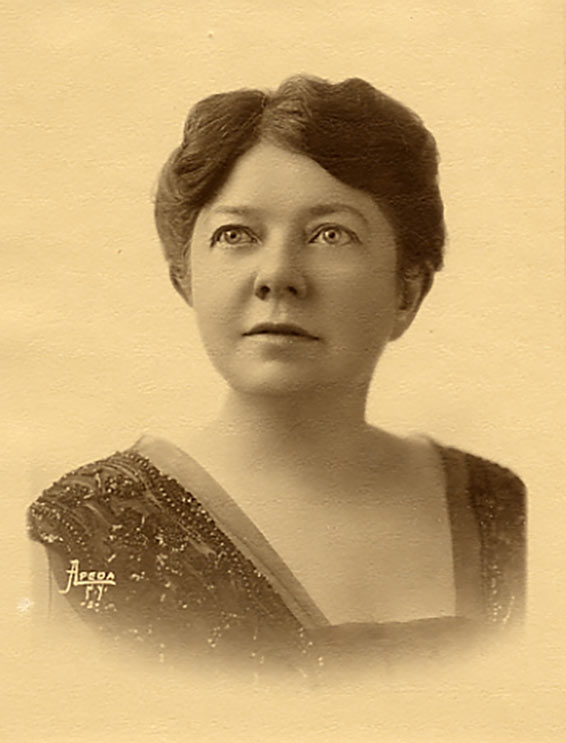 Amy Beach, Apeda, New York, vers 1900.
Amy Beach, Apeda, New York, vers 1900.
Catalogue des œuvres ; Écrits ; Bibliographie ; Discopgraphie.
Né à Henniker, New Hampshire, 5 septembre 1867 ; morte à New York, 27 décembre 1944.
Compositrice et pianiste.
Elle était la fille unique de Charles Abbott Cheney (1844-1895), fabricant et importateur de papier, et de Clara Imogene Marcy (1844-1911).
Les Cheney s’installèrent à Chelsea, dans le Massachusetts, vers 1871. Amy Beach était âgée de 6 ans quand sa mère lui donna ses premiers cours de piano.
En 1875, la famille s’installa à Boston, et fit appel un premier professeur de piano, Johann Ernst Perabo (1844-1920), plus tard, Carl Baermann (1839-1913), tous deux immigrés allemands. Elle prit également des cours d’harmonie et de contrepoint avec Junius W. Hill, au Wellesley College en 1881.
Ses premières compositions datent de 1877, mais The Rainy Day, une mélodie avec accompagnement de piano sur un poème d’Henry Longfellow, qui date de 1880, fut sa première œuvre éditée en 1883.
Amy Beach (Henry Wadsworth Longfellow), The Rainy Day, Katherine Kelton (soprano) Catherine Bringerud (piano), 2004.Elle fait ses débuts de pianiste à Boston le 24 octobre 1883, lors d'un « Concert Promenade » dirigé par Adolph Neuendorff, au Boston's Music Hall, avec le rondo en mi bémol de Frédéric Chopin et le concerto no 3, en sol mineur d’Ignaz Moscheles. Le 28 mars 1885, elle interprèta le concerto en fa mineur de Chopin avec, pour la première fois, l’Orchestre symphonique de Boston, sous la direction de Wilhelm Gericke. La mois suivant, elle interpréta le concerto pour piano et orchestre en ré mineur de Félix Mendelssohn, sous la direction de Theodore Thomas, avec son orchestre.
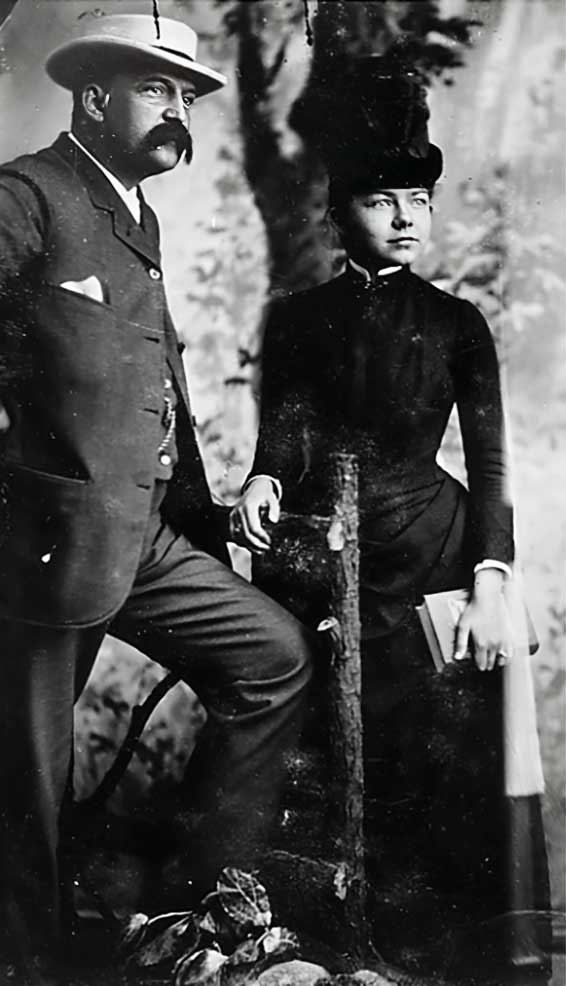 Henry Harris Aubrey Beach et Amy Beach en 1886.
Henry Harris Aubrey Beach et Amy Beach en 1886.
Elle se maria, en 1885, avec le docteur Henry Harris Aubrey Beach (1843-1910), un ami de la famille de 24 ans son aîné, pour lui un second mariage. Chanteur amateur, il enseignait à la faculté de médecine d’Harvard et pratiquait à l’Hôpital général du Massachusetts. Comme femme mariée, elle dut mettre fin à sa carrière de concertiste, excepté quelques concerts caritatifs, mai put se consacrer à la composition.
Les conditions de son mariage incluaient de vivre en tant que dame de compagnie et mécène, ne jamais enseigner le piano, de limiter ses concerts à deux récitals publics par an, dont les bénéfices seraient reversés à des œuvres caritatives, il lui était interdit d’étudier avec un tuteur, un éducateur ou un collègue.
Elle étudia donc la composition en autodidacte, sur les conseils de Wilhelm Gericke, en s’inspirant des maîtres et en traduisant les traités d’Hector Berlioz et de François-Auguste Gevaert.
Elle fut alors très prolifique avec de grandes formes comme la messe en mi bémol majeur, opus 5 (1890), qui fut créée en février 1892, au Boston Music Hall, par la Handel and Haydn Society ; la Symphonie, opus 32 (1906), ou nombre de mélodies qui furent très prisées. Elle reçoit aussi des commandes pour des inaugurations d’expositions, ou de sociétés musicales. Des compositions qu’elle signe du nom de son mari : Mrs H. H. A. Beach.
Après la mort de Charles Abbott Cheney en 1895, le père d'Amy Beach, sa veuve s'installa au domicile du docteur Beach.
Amy Beach, Messe en mi bémol majeur, opus 5, Kyrie, InYoung Lee (soprano), Emily Bullock (mezzo soprano), Stephen Ng (ténor), Nicholas Provenzale (baritone), West Chester University Wells School of Music, University Orchestra, Concert Choir and Mastersingers; sous la doirection de David P. DeVenney.Composée en 1893, le succès de sa mélodie, Ecstasy, pour voix et piano, lui permit d’acheter un terrain à Centerville on Cape Cod, dans le Massachusetts.
Amy Beach, Ecstasy, Ophelia Trio, Marjoleine Schaap (soprano), Karin Dolman (viola), Caecilia Boschman (piano).La Gaelic Symphony, première symphonie composée et publiée par une Américaine, fut créée le 30 octobre 1896, par l'Orchestre symphonique de Boston.
Amy Beach, Gaelic Symphony, I. Allegro con fuoco, II. Alla siciliana – Allegro vivace, III. Lento con molto espressione, IV. Allegro di molto, Portland Youth Philharmonic; sous la direction de David Hattner.En 1900, l'Orchestre symphonique de Boston créa le Concerto pour piano, où elle joua en personne la partie soliste. On peut penser qu’elle avait ouvert la contestation contre sa mère et son mari pour le contrôle de son autonomie.
Après la mort de son mari en 1910 et de sa mère en 1911, Amy Beach embarque pour l’Europe le 5 septembre 1911, en compagnie de Marcella Craft (1874-1959), soprano et prima donna américaine de l'Opéra royal de Berlin.
En octobre 1912, elle fit ses débuts européen à Dresde avec sa propre sonate pour violon et piano aux côtés du violoniste (et avocat), Franz Wolfgang Bülau (1883-1950).
Amy Beach, Sonate pour violon et piano en la mineur, 1 Allegro Moderato, 2. Scherzo: Molto vivace, 3. Largo con dolore, 4. Allegro con fuoco, Sophie Bird (violon) Justin Bird (piano), Ford-Crawford Hall, Bloomington, 4 avril 2013.À partir de l’automne 1912, elle donne des récitals dans les villes allemandes, Leipzig, Berlin, Hamburg, jouant ses œuvres : sa sonate, concerto, quintette, accompagnant ses mélodies, symphonie. Les critiques sont favorables tant pour ses compositions que pour ses qualités de pianiste.
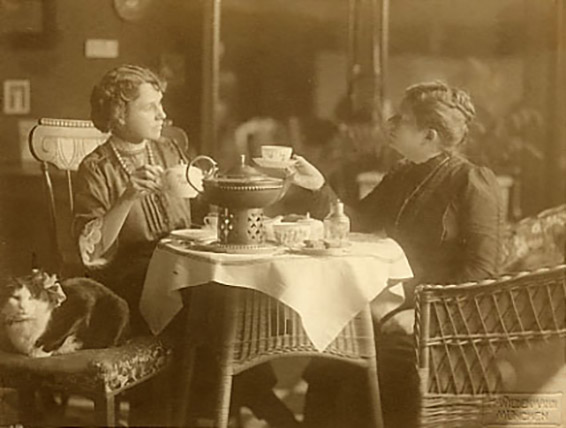 Marcella Craft et Amy Beach à Munich en 1913.
Marcella Craft et Amy Beach à Munich en 1913.
Au début de la Première Guerre mondiale, elle revint aux États-Unis, avec un nombre important de concerts programmés.
Elle s’est installée à New York, dans un appartement de l'American Women's Club, sur la 57e Rue.
Par la suite, elle fit des tournées de concerts en hiver et consacra les étés à la composition, à Hillsborough ou à Centerville on Cape Cod.
Elle fut compositrice en résidence (virtuelle) à l’église épiscopale St Bartholomew de New York.
Quand en 1921, elle fut Boursière de la MacDowell Colony, elle séjourna souvent à la MacDowell Colony de Peterborough, dans le New Hampshire, mais c’est à Centerville qu’elle composa l’essentiel de son œuvre.
Amy Beach, Quatuor pour cordes en 1 mouvement, opus 89, the Dover Quartet, Modern Art Museum of Fort Worth, 11 février 2023.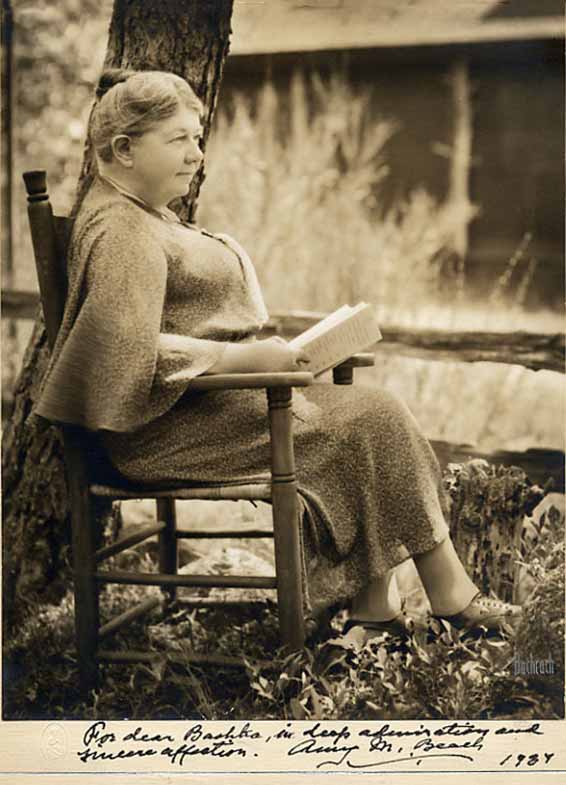 Amy Beach en 1934, à Centerville on Cape Cod « For dear Bashka, in deep admiration and sincere affection. Amy M. Beach, 1934. ».
Amy Beach en 1934, à Centerville on Cape Cod « For dear Bashka, in deep admiration and sincere affection. Amy M. Beach, 1934. ».
Elle reçut un master honorifique de l'Université du New Hampshire.
En 1925, elle fonda et fut la première présidente de la Society of American Women Composers.
Elle séjourna en 1929 à Rome, où elle acheva son quatuor à cordes.
Elle a dirigé la Music Teachers National Association et la Music Educators National Conference.
En 1942, Elena de Sayn, violoniste et critique, a organisé deux concerts à Washington pour célébrer le 75e anniversaire d’Amy Beach.
Catalogue des œuvres
1877, Romanza, piano.
1877, Air and Variations, piano.
1877, Mamma’s Waltz, piano.
1877, Menuetto, piano
1877, Petite valse, piano.
1880, The Rainy Day (H. Longfellow), 1voix, piano.
1882, 4 Chorales, Come ye faithful (J. Hupton); Come to me (C. Elliott); O Lord, how happy should we be (J. Anstice); To heav’n I lift my waiting eyes, chœur mixte.
1885-1887, opus 1, Four Songs, pour 1 voix et piano, With violets, sol majeur (K. Vannah) (1885), The four Brother (F. von Schiller) (1887), Jeune fille et jeune fleur, do dièse mineir (F. R. Chateaubriand) (1887), Ariette (P. B. Shelley) (1886).
1886, opus 30, The Rose of AvonTown (C. Mischka), chœur féminin, piano ou orchestre.
1887, Arrangement pour piano à quatre mains du 2e mouvement du premier concerto pour piano de Ludwig van Beethoven.
1887-1889, opus 12, Three Songs, 1 voix et piano sur des poèmes de R. Burns, Wilt thou be my dearie ? Ye banks and braes o’ bonnie doon, My love is like a red rose.
1887-1891, opus 2, Three Songs, pour 1 voix et piano, Twilight (A.M. Beach) (1887), When far from her (H.H.A. Beach) (1889), Empress of night (H.H.A. Beach) (1891).
1888, opus 3, Cadenza pour le 1er mouvement du 3e concerto (do mineur) pour piano de Ludwig Van Beethoven.
1889, opus 4, Valse-caprice, pour piano.
1889, St John the Baptist (Matthew, Luke).
1889-1890, opus 11, Three Songs sur des poèmes de W. E. Henley, Dark is the night (1890), The Western Wind (1889), The Blackbird (1889).
1890, opus 10, 3, Songs of the Sea, duos pour soprano, baryton et piano, « A Canadian Boat Song » (T. Moore), soprano, basse, piano ; « The Night Sea » (H.P. Spofford), soprano, piano ; « Sea Song » (W.E. Channing).
1890, opus 14, Four Songs, pour 1 voix et piano, The Summer Wind (W. Learned), Le secret (J. de Resseguier), Sweetheart, sigh no more (T.B. Aldrich), The Thrush (E.R. Sill) (nos 2 et 3 revisés en 1901).
1890, opus 16, The Minstrel and the King (F. von Schiller), chœur masculin, orchestre.
1890, opus 5, Mass, en mi bémol mineur, solistes, chœur mixye et orchestre.
1891, opus 9, The Little Brown Bee (M. Eytinge), chœur féminin à quatre voix.
1891, opus 13, Hymn of Trust (O. W. Holmes) (revisé avec violon obligée en (1901)
1891, opus 7, O praise the Lord, all ye nations (Ps cxvii), à 4 voix et orgue.
1891, opus 8, Choral Responses, à quatre voix et orgue, Nunc dimittis (Luke ii.29), With prayer and supplication (Philippians iv.6-7), Peace I leave with you (John iv.27).
1892, Graduale (Thou Glory of Jerusalem), ténor et orchestra (supplément à la messe opus 5).
1892, opus 17, Festival Jubilate (Ps c), en ré majeur, chœur mixte te orchestre.
1892, opus 15, Four Sketches, pour piano, 1. In Autumn, 2. Phantoms, 3. Dreaming, 4. Fireflies.
1892, opus 18, Eilende Wolken, Segler die Lüfte, d'après Marie Stuart de Friedrich von Schiller, voix d’alto et orchestre, 1892.
1893, 3 mouvements pour piano à quatre mains.
1893, opus 19, Three Songs pour 1 voix et piano et violon obligé, me the jasmine buds unfold (F.E. Coates), Ecstasy (A. M. Beach).
1893, opus 21, Three Songs, pour 1 voix et piano (aussi pour orchestre), Chanson d’amour (V. Hugo), Extase (Hugo), Elle et moi (F. Bovet).
1893, opus 22, Bal masqué, valse, pour orchestre (version pour piano en 1894)
1893, opus 23, Romance, pour violon et piano.
1893, opus 24, Bethlehem, à quatre voix et orgue sur un texte de George C. Hugg.
1894, opus 20, Villanelle, « Across the World » (E.M. Thomas), arrangement 1 voix, violoncelle oblige.
1894, opus 25, Children’s Carnival, pour piano, 1. Promenade, 2. Columbine, 3. Pantalon, Pierrot and Pierrette.
1894, opus 26, Four Songs, pour 1 voix et piano, My Star (C. Fabbri), Just pour this (Fabbri), Spring (Fabbri), Wouldn’t that be queer (E.J. Cooley) (no 4, arrangement pour chœur en 1919).
1894, opus 29, Four Songs, pour 1 voix et piano, Within thy heart (A.M. Beach), The Wandering Knight (anonyme), Sleep, little darling (Spofford), Haste, O beloved (W.A. Sparrow).
1894, opus 6, Ballad, pour piano, en ré bémol majeur.
1894, opus 28, Three compositions, pour piano, Barcarolle (révision, en 1937, arrangement violon et piano en 1937), Minuet italien, Danse des fleurs.
1894-1896, opus 32, Gaelic Symphony, en mi mineur.1895, An Indian Lullaby (anon.), chœur féminin à quatre voix (1895)
1895, opus 27, Alleluia, Christ is risen, d’après M. Weisse, C. F. Gellert, T. Scott, T. Gibbons, à quatre voix et orgue (version avec violon obligé).
1895, opus 33, Teach me thy way (Ps lxxxvi.11-12).
1896, Arrangement scène 3, acte I des Troyens, d'Hector Berlioz, pour 1 voix et piano.
1896, opus 34, sonate pour violon et piano en la mineur (existe pour alto et piano, flûte et piano).
1896, opus 31, Three Flower Songs (M. Deland), chœur féminin à quatre voix, piano, « The Clover », « The Yellow Daisy », « The Bluebell ».
1896, opus 35, Four Songs, pour 1 voix et piano, Nachts (C.F. Scherenberg), Allein ! (H. Heine), Nähe des Geliebten (J.W. von Goethe), Forget-me-not (H.H.A. Beach).
1897, opus 36, Children’s Album, pour piano, Minuet, Gavotte, Waltz, March, Polka
1897, opus 37, Three Shakespeare Songs, pour 1 voix et piano, O mistress mine, Take, O take those lips away, Fairy Lullaby (no 3 arrangement pour chœur en 1907.
1897, opus 38, Peace on earth ? Sur un texte d’E.H. Sears.
1897, opus 39, Three Shakespeare Choruses, chœur féminin à quatre voix, piano, Over hill, over dale, Come unto these yellow sands, Through the house give glimmering light.
1898, opus 40, Three Compositions, pour violon et piano (arrangement pour violoncelle en 1903, La captive, Berceuse, Mazurka.
1898, opus 41, Three Songs, pour voix et piano, Anita (Fabbri), Thy beauty (Spofford), Forgotten (Fabbri).
1898, opus 42, Song of Welcome (H.M. Blossom), chœur mixte avec accompagnement de piano, grand orchestre ou ensemble à vent et tambours.
1899, , opus 45, Concerto pour piano, en do dièse mineur, 1899 (arrangement pour 2 pianos en 1900).
1899, opus 43, Five Burns Songs, pour 1 voix et piano, Dearie, Scottish Cradle Song, Oh were my love yon lilac fair!, Far awa’, My lassie (no 3 arrangements pour 2 sopranos en 1918 ; no 4 arrangements en 1918 pour chœur, à 2 voix, chœur féminin, en 1936, orgue ou piano).
1900, opus 44, Three [R.] Browning Songs, pour 1 voix et piano, The year’s at the spring, Ah, love but a day, I send my heart up to thee (nombreux arrangements ultérieurs).
1901, opus 46, Sylvania, a Wedding Cantata sur un texte de F. W. Bancroft, d’après W. Bloem, soprano, double chœur mixte, orchestre.
1901, opus 47, Summer Dreams, 6 duets pour piano 4 mains, The Brownies, Robin Redbreast, Twilight, Katy-dids, Fafin Tarantelle, Goodnight.
1902, opus 48, Four Songs, pour 1 voix et piano, Come, ah come (H. H. A. Beach), Good Morning (A.H. Lockhart), Good Night (Lockhart), Canzonetta (A. Sylvestre).
1902, opus 49, A Song of Liberty (F. L. Stanton), à quatre voix, orchestre, 1902 (arrangement pour chœur masculin à quatre voix et piano en 1917).
1902, Serenade, piano (transcription de Ständchen de Richard Strauss).
1903, opus 54, 2 pièces pour piano, Scottish Legend, Gavotte fantastique.
1903, opus 50, Help us, O God (Pss lxxix.9, 5 ; xlv.6 ; xliv.26), Motet pour chœur a cappella.
1903, opus 51, Four Songs, pour 1 voix et piano, Ich sagte nicht (E. Wissman) ; Wir drei (H. Eschelbach), Juni (E. Jansen), Je demande à l’oiseau (Sylvestre).
s.d., opus 51 (?), Four Songs, pour 1 voix et piano, 1. Silent Love, do majeur, 2. We Three, la bémol majeur, 3. June, Fa majeur, 4. For my Love, la bémol majeur.
1903, opus 52, A Hymn of Freedom, America, sur un texte de S. F. Smith, à 4 voix, orgue ou piano (révisé avec le texte de O Lord our God arise en 1944).
1903, opus 53, Jephthah’s Daughter, (La fille de Jephté), aria, texte de Charles-Louis Mollevaut, d’après la Bible, Juges 11:38, traduction anglaise par la compositrice pour soprano et orchestre ou piano.
1903, opus 56, Four Songs, pour 1 voix et piano, Autumn Song (H.H.A. Beach), Go not too far (F.E. Coates), I know not how to find the spring (Coates), Shena Van (W. Black).
1904, opus 55, Invocation, pour violon et piano ou orgue et violoncelle obligé.
1904, opus 59, The Sea-Fairies (A. Tennyson), soprano, alto, chœur féminin à 2 voix, orchestre, orgue ad libitum (aussi accompagnement, harpe ou piano).
1904, opus 60, Variations on Balkan Themes, pour piano. 1904 (orchestré en 1906, revisé en 1936, arrangement pour 2 pianos en 1937.
1905, opus 63, Service, en la majeur, voix d’alto, 4 voix mixtes, orgue : Te Deum, Benedictus (révision sans Gloria en 1934.
1905, opus 61, Give me not love (Coates), soprano, ténor, piano.
1905, opus 62, When soul is joined to soul (E.B. Browning), voix et piano.
1906, Jubilate Deo, Magnificat, Nunc dimittis, 4 voix et orgue.
1907, opus 37, Fairy Lullaby (W. Shakespeare), chœur féminin à quatre voix.
1907, opus 65, Suite française, pour piano, Les rêves de Columbine, La fée de la fontaine, Le prince gracieux, Valse étoiles, Danse d’Arlequin.
1907, opus 67, Quintette avec piano en fa mineur.
1907, opus 66, The Chambered Nautilus (Holmes), soprano, alto, chœur féminin à quatre voix, orchestre, orgue ad libitum.
1907, opus, Eskimos, Four Characteristic Pieces, pour piano, Arctic Night, The Returning Hunter, Exiles, With Dog Teams (révisé en 1943)
1908, opus 69, Two Mother Songs, pour 1 voix et piano, Baby (G. MacDonald), Hush, baby dear (A.L. Hughes).
1909, 1927, opus 44.1-2, The year’s at the spring (R. Browning) ; Ah, love, but a day (Browning), chœur féminin à quatre voix, piano (1927).
1909, opus 68, After (Coates), pour 12 voix piano et piano (plusieurs arrangements).
1910, opus 70, Iverniana, pour 2 pianos (perdu).
1910, opus 71, Three Songs, pour 1 voix et piano, A Prelude (A. M. Beach), O sweet content (T. Dekker), An Old Love-Story (B.L. Stathem).
1914, opus 57, Only a Song (A.L. Hughes), One Summer Day (Hughes), chœur féminin à quatre voix.
1914, opus 72, Two Songs, pour 1 voix et piano, Ein altes Gebet, Deine Blumen (L. Zacharias).
1914, opus 73, Two Songs (Zacharias), pour 1 voix et piano, Grossmütterchen, Der Totenkranz.
1914, opus 74, All hail the power of Jesus’ name, texte d’E. Perronet, 4 voix, orgue ou piano.
1914, opus 75, 4 mélodies, pour 1 voix et piano, The Candy Lion (A.F. Brown), A Thanksgiving Fable (D. Herford), Dolladine (W.B. Rands), Prayer of a Tired Child (Brown) (nos 1 et 3 arrangés pour chœur féminin en 1915).
1914, opus 76, Two Songs, pour 1 voix et piano, Separation (J.L. Stoddard), The Lotos Isles (Tennyson).
1915, opus 74, Panama Hymn (W.P. Stafford), chœur mixte, orchestre (ou orgue ou piano).
1915, opus 75, The Candy Lion (A. F. Brown), Dolladine (W.B. Rands), chœur féminin à quatre voix.
1915, opus 76, Thou knowest, Lord, texte de J. Borthwick, ténor, basse, 4 voix, et orgue.
1916, Balloons (L. A. Garnett), chœur d’enfants.
1916, opus 77, Two Songs, pour 1 voix et piano, I (C. Fanning), Wind o’ the Westland (D. Burnett).
1916, opus 78, Canticles pour soprano, 4 voix et orgue, Bonum est, confiteri (Ps xcii. 1-4), Deus misereatur (Ps lxvii) ; Cantate Domino (Ps xcviii) ; Benedic, anima mea (Ps ciii).
1916, opus 80, Theme and Variations, flûte, quatuor à cordes.
1917, Friends (Brown), chœur d’enfants à 2 voix.
1917, opus 56, 4 songs, 4.Shena Van (William Black), chœur féminin à 3 voix ou chœur masculin à 4 voix.
1917, opus 78, Three Songs, pour 1 voix et piano, Meadowlarks (I. Coolbrith), Night Song at Amalfi (Teasdale), In Blossom Time (Coolbrith).
1917, opus 81, Prelude and Fugue, pour piano.
1917, opus 82, Dusk in June (S. Teasdale), chœur féminin à quatre voix.
1918, opus 43.4, Far Awa' (R. Burns), chœur féminin à 3 voix, piano.
1919, opus 26, Wouldn't that be queer (E. J. Cooley), chœur féminin à 3 voix et piano.
1928, opus 120, Rendez-vous (Speyer), pour 1 voix et violon obligé.
1921, Caprice, The Water Sprites, flûte, violoncelle, piano.
1921, opus 86, May Eve, à quatre voix, piano.
1921, opus 90, Pastorale, pour flûte, violoncelle et piano (existe arrangement violoncelle et orgue, violoncelle et piano).
1922, Clouds (F.D. Sherman), pour 1 voix et piano.
1922, opus 93, Message (Teasdale), pour 1 voix et piano.
1922, opus 83, From Blackbird Hills, pour piano.
1922, opus 84, Te Deum, en fa mineur, ténor, chœur masculin à trois voix, orgue.
1922, opus 85, In the Twilight (Longfellow) , 1922
1922, opus 88, Spirit Divine (A. Read), soprano, tenor, orgue.
1922, opus 91, The Fair Hills of Eire, pour piano ou orgue (révisé comme Prelude on an Old Folk Tune, pour orgue en 1921
1921-1922, opus 92, 1. Hermit Thrush at Eve, 2. Hermit Thrush at Morn, pour piano.
1922, opus 95, Constant Christmas, texte de P. Brooks, soprano, alto, chœur mixte et orgue.
1922, opus 97, From Grandmother’s Garden, pour piano, « Morning Glories », « Heartsease », « Mignonette », « Rosemary and Rue, Honeysuckle ».
1922, The Arrow and the Song (H.W. Longfellow), pour 1 voix et piano.
1922, A Song pour Little May (E.H. Miller), pour 1 voix et piano.
1923, opus 96, The Lord is my shepherd (Ps xxiii), chœur féminin à trois voix, et orgue.
1923, opus 101, Peter Pan (J. Andrews), chœur féminin à 3 voix.
1923, opus 87, Fantasia fugata, pour piano.
1923, opus 98, I will lift up mine eyes (Ps cxxi), chœur mixte et orgue.
1923, opus 99, Four Songs, pour 1 voix et piano, When Mama Sings (A.M. Beach), Little Brown-Eyed Laddie (A.D.O. Greenwood), The Moonpath (K. Adams), The Artless Maid (L. Barili).
1924, , opus 105, Let this mind be in you (Philippians ii.5-11), soprano, basse, chœur mixte et orgue.
1924, opus 100, Two Songs, soprano, violon, violoncelle, piano, A Mirage (B. Ochsner); Stella viatoris (J.H. Nettleton),
1924, opus 102, Piano Compositions, 1. Farewell Summer, 2. Dancing Leaves.
1924, opus 103, Benedictus es, Domine, Benedictus (Luke i.67-81), basse, chœur mixte et orgue.
1924, opus 104, Suite for Two Pianos Founded upon Old Irish Melodies.
1924, opus 106, Old Chapel by Moonlight, pour piano.
1924, opus 107, Nocturne, pour piano.
1924, opus 108, A Cradle Song of the Lonely Mother, pour piano.
1925, opus 109, Lord of the worlds above, text de I. Watts, soprano, ténor, basse, chœur mixte et orgue.
1925, opus 110, The Greenwood (W.L. Bowles), à quatre voix.
s.d., opus 111, From Olden Times, pour piano.
1925, opus 112, Jesus my Saviour (A. Elliott), pour 1 voix et piano.
1925, opus 114, By the Still, pour piano.
1925, opus 115, Around the Manger, texte de R. Davis, chœur mixte et orgue ou piano (version pour 1 voix et piano ou orgue ; révision chœur féminin à trois voix, orgue ou piano, revision chœur féminin à quatre voix, et orgue ou piano en 1929).
1925-1926, opus 117, Three Songs, pour 1 voix et piano sur des poèmes de M. Lee, The Singer, The Host, Song in the Hills.
1926, Birth (E. L. Knowles), pur 1 voix et piano.
1926, opus 113, Mine be the lips (L. Speyer), pour 1 voix et piano.
1926, opus 116, Tyrolean Valse-fantaisie, pour piano.
1927, opus 119, From Six to Twelve, pour piano.
1928, A Bit of Cairo, pour piano.
1928, opus 121, Benedicite omnia opera Domini (Daniel iii. 56-58).
1928, opus 122, Communion Responses, Kyrie, Gloria tibi, Sursum corda, Sanctus, Agnus Dei, Gloria, soprano, alto, ténor, basse, chœur mixte et orgue.
1928, opus 123, The Canticle of the Sun (St Francis), soprano, mezzo-soprano, tenor, basse, chœur mixte, orchestre.
1929, Arrangement de On a hill : Negro melody (traditionnel), 1voix, piano.
1929, Mignonnette, pour 1 voix et piano.
1929, opus 124, Springtime (S.M. Heywood), pour 1 voix et piano.
1929, opus 89, quatuor à cordes en un mouvement.
1930, A September Forest, pour piano.
1930, opus 126, Sea Fever (J. Masefield), The Last Prayer, chœur masculine à quatre voix, piano.
1930-1936, opus 125, Two Sacred Songs, pour 1 voix et piano, Spirit of Mercy (anonyme), Evening Hymn, The shadows of the evening hours (A. Procter).
1931, fragment de prélude, violon, violoncelle, piano.
1931, opus 51, Juni (E. Jensen), à quatre voix, piano (aussi version pour chœur féminin à 3 voix).
1931, opus 127, When the last sea is sailed (Masefield), chœur masculin à quatre voix.
1931, opus 132, Christ in the universe (A. Meynell), alto, ténor, chœur mixte, orchestra.
1932, opus 128, Three piano Pieces, Scherzino, : a Peterborough Chipmunk, Young Birches, A Humming Bird.
1932, opus 129, Drowsy Dream Town (R. Norwood), soprano, chœur féminin à 3 voix, piano.
1932, opus 131, Dark Garden (Speyer), pour 1 voix et piano.
1932, opus 130, Out of the Depths, pour piano.
1932, opus 133, Four Choral Responses (J. Fischer).
s.d., opus 134, God is our stronghold (E. Wordsworth), soprano, chœur mixte et orgue.
1932, opus 136, Fire and Flame (A. A. Moody), pour 1 voix et piano.
1932, opus 137, Baby (S.R. Quick); May Flowers (Moody)
1932, opus 143, I shall be brave (Adams), pour 1 voix et piano.
1932, opus 149, Cabildo, opéra en 1 acte, sur un livret de N.B. Stephens, voix solistes, chœur, récitant, trio avec violon.
1932, opus 135, To one I love, pour 1 voix et piano.
1933, opus 94, Three School Songs, à quatre voix.
1934, opus 139, Hearken unto me (Isaiah li.1, 3; xliii.1-3 ; xl.28, 31), soprano, alto, ténor, basse, chœur mixte, orchestre.
1934, Evening song, 1934, pour 1 voix et piano.
1934, opus 125, Evening Hymn, The shadows of the evening hours, texte d’A. Procter, soprano, alto, chœur mixte.
1934, opus 140, We who sing have walked in glory (A.S. Bridgman), 1 voix et piano.
1934, opus 148, Five Improvisations, pour piano.
1935, April Dreams (K.W. Harding), pour 1 voix et piano.
1935, opus 141, O Lord, God of Israel (1 Kings viii.23, 27-30, 34), soprano, alto, basse, chœur mixte.
1935, opus 144, This morning very early (P.L. Hills), chœur féminin à 3 voix, piano.
1936, Agnus Dei, soprano ou alto, chœur, orgue ou piano (supplément à l’opus 122).
1936. opus 125, Lento espressivo, violon et piano
1936, opus 142, I sought the Lord (anonyme), pour 1 voix et piano.
1938, opus 146, Lord of all being (O.W. Holmes), 1 voix et piano.
1938, opus 150, Trio avec piano.
1938, opus 118, The Moonboat (E.D. Watkins), Who has seen the wind (C. Rossetti), chœur d’enfants à 2 voix.
s.d., opus 145, Dreams, pour 1 voix et piano.
1939, opus 147, I will give thanks (Ps cxi), soprano, chœur mixte et orgue (1939).
1941, Hymn, O God of love, O King of peace (H.W. Baker), à quatre voix.
1941, opus 152, Though I Take the Wings of Morning (R.N. Spencer), 1voix et piano.
1942, opus 151, Pastorale, pour quintette à vent.
1944, Pax nobiscum (E. Marlatt), (chœur féminin à trois voix ou chœur masculin à 3 ou 4 voix et orgue.
1944, The Ballad of the P.E.O. (R.C. Mitchell) chœur féminin.
s.d., Allegro appassionata, Moderato, Allegro con fuoco, piano 4 mains.
s.d., Du sieh'st, basse et piano, 1 voix ou piano (fragment).
s.d., If women will not be inclined, 1voix et piano.
s.d., Singing Joyfully (J.W. Chadwick), chœur d’enfants à 2 voix et piano.
s.d., The heart that melts, 1 voix et piano.
s.d., The Icicle Lesson, 1 voix et piano.
s.d., Time has wings and swiftly flies, 1voix et piano.
s.d., Whither (W. Müller) , 1 voix et piano.
s.d., The Deep Sea Pearl (E.M. Thomas), pour 1 voix et piano.
Écrits
Cristofori redivivus, dans « Music » (xvi), May 1899, p. 1-5
Why I Chose my Profession: the Autobiography of a Woman Composer, dans « Mother’s Magazine » (xi) Feb 1914, p. 7-8.
The Outlook pour the Young American Composer, dans « The Etude » (xxxiii), 1915, p. 13-14.
Music’s Ten Commandments as given pour Young Composers, dans « Los Angeles Examiner » 28 June 1915.
Common Sense in Pianoforte Touch and Technic, dans « The Etude » (xxxiv), 1916, p. 701-702.
To the Girl who Wants to Compose, dans « The Etude » (xxxv), 1918, p. 695.
Work out your own Salvation, dans « The Etude » (xxxvi), 1918, p. 11-12.
Emotion Versus Intellect in Music, dans « Studies in Musical Education, History, and Aesthetics » (xxvi), 1932, p. 17-19.
The Twenty-Fifth Anniversary of a Vision, dans « Studies in Musical Education, History, and Aesthetics » (xxvii), 1933, p. 45-48.
A Plea pour Mercy, dans « Studies in Musical Education, History, and Aesthetics » (xxx), 1936, p. 163-165.
The Mission of the Present Day Composer, dans « Triangle of Mu Phi Epsilon » (xxxvi), Feb 1942, p. 71–72.
How Music is Made, dans « Keyboard » (iv), 1942, p. 11, 38.
The « How » of Creative Composition, dans « The Etude » (lxi), 1943, p. 151, 206, 208-209.
The World Cries out pour Harmony, dans « The Etude », (lxvii), 1944, p. 11.
Los Angeles « Fairyland » Marks an Epoch in American Music, dans H. Parker, « Fairyland Scrapbook » US-NH.
Music After Marriage and Motherhood, dans « Etude » , s. d.
Bibliographie
Fried Block Adrienne, Why Amy Beach Succeeded as a Composer : the Early Years’, dans « Current Musicology », (36), New York, 1983, p. 41-59.
Marmaduke Sidney Miles, The Solo Piano Works of Mrs. H.H.A. Beach (thèse), Peabody Institute, Johns Hopkins University 1985.
Petteys Leslie, Cabildo by Amy Marcy Beach, dans « Opera Journal » (22), March 1989, p. 10-19.
Kelton Mary Katherine, Mrs. H.H.A. Beach and Her Songs for Solo Voice, dans « Journal of Singing » (52), January-February 1996, p. 3-23.
Fried Block Adrienne, Amy Beach, Passionate Victorian: an American Composer’s Life and Work. Oxford University Press 1998.
Robinson Nicole Marie, To the Girl Who Wants to Compose: Amy Beach as a Music Educator (Master’s thesis), The Florida State University, 2013.
Discographie
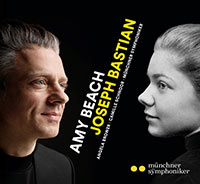 Amy Beach (1967-1944), Camille Schnoor (soprano), Angela Brower (mezzo-soprano), Münchner Symphoniker, sous la direction de Joseph Bastian, Gaelic Symphony, Marie Stuart, Jephthah's Daughter, Extase, Bal masqué. Sopo Musica 2025 (SM 488). Enregistré les 25-27 septembre 2024, Bavaria Musikstudios München [+++ Lire la présentation].
Amy Beach (1967-1944), Camille Schnoor (soprano), Angela Brower (mezzo-soprano), Münchner Symphoniker, sous la direction de Joseph Bastian, Gaelic Symphony, Marie Stuart, Jephthah's Daughter, Extase, Bal masqué. Sopo Musica 2025 (SM 488). Enregistré les 25-27 septembre 2024, Bavaria Musikstudios München [+++ Lire la présentation].
25 mai 2025
© Musicologie.org.
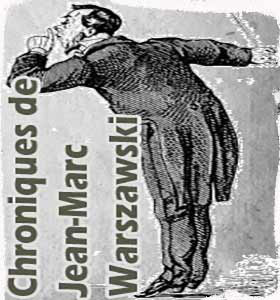
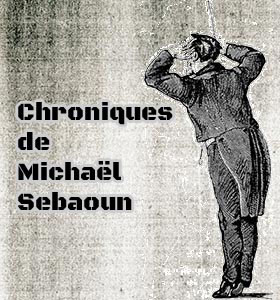
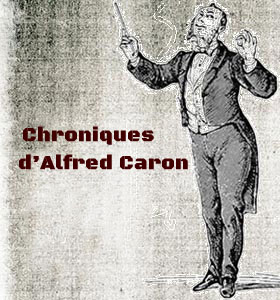
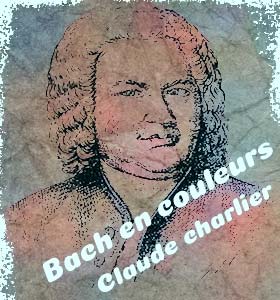
 À propos - contact |
S'abonner au bulletin
| Biographies de musiciens | Encyclopédie musicale | Articles et études | La petite bibliothèque | Analyses musicales | Nouveaux livres | Nouveaux disques | Agenda | Petites annonces | Téléchargements | Presse internationale | Colloques & conférences | Collaborations éditoriales | Soutenir musicologie.org.
À propos - contact |
S'abonner au bulletin
| Biographies de musiciens | Encyclopédie musicale | Articles et études | La petite bibliothèque | Analyses musicales | Nouveaux livres | Nouveaux disques | Agenda | Petites annonces | Téléchargements | Presse internationale | Colloques & conférences | Collaborations éditoriales | Soutenir musicologie.org.
Musicologie.org, 56 rue de la Fédération, 93100 Montreuil. ☎ 06 06 61 73 41.
ISSN 2269-9910.
Samedi 15 Novembre, 2025


